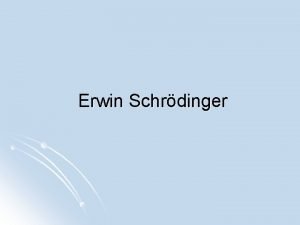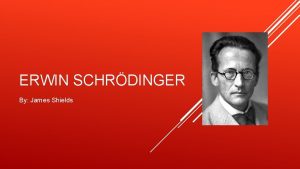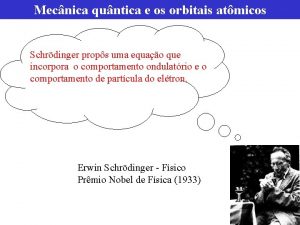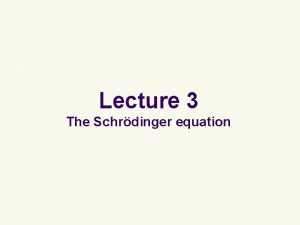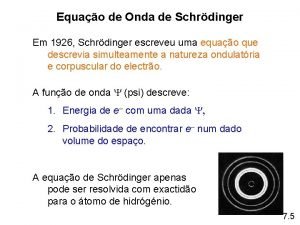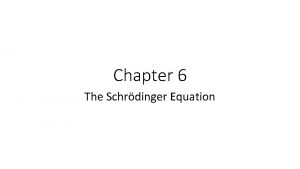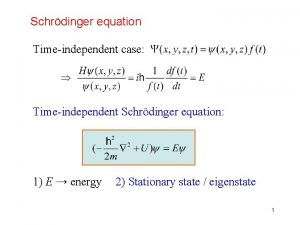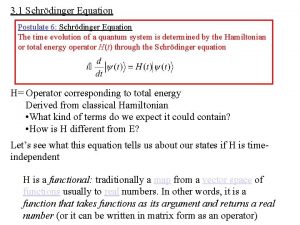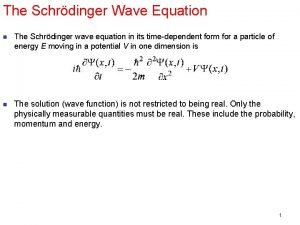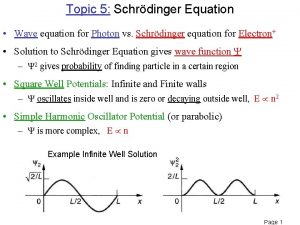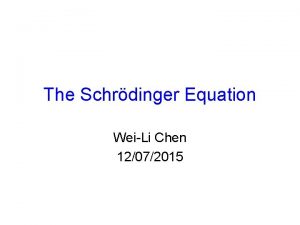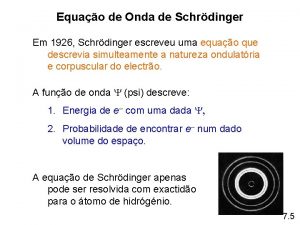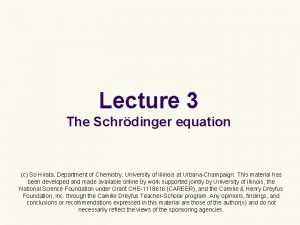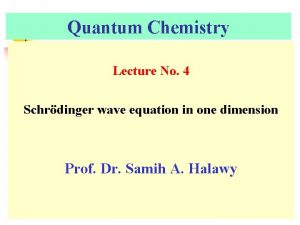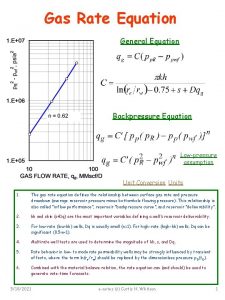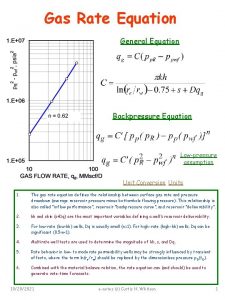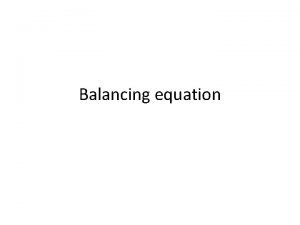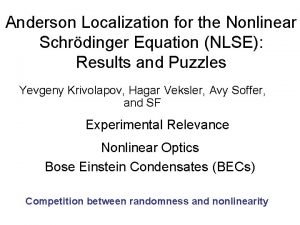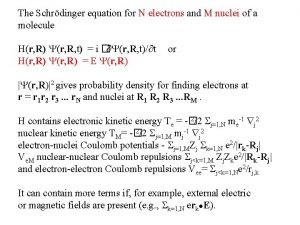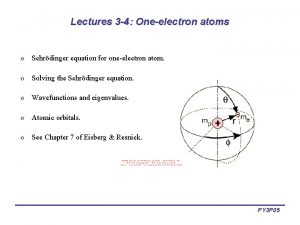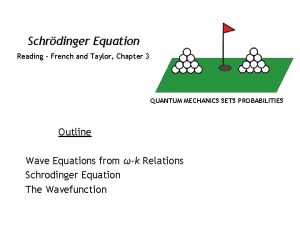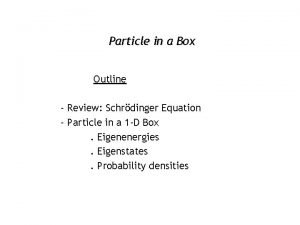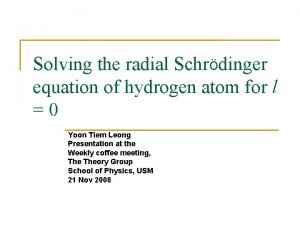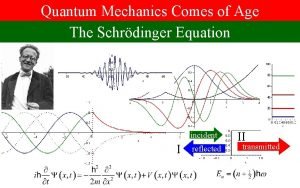Lecture 3 The Schrdinger equation The Schrdinger equation




























- Slides: 28

Lecture 3 The Schrödinger equation

The Schrödinger equation l l We introduce the Schrödinger equation as the equation of motion of quantum chemistry. We cannot derive it; we postulate it. Its correctness is confirmed by its successful quantitative explanations of all known experimental observations. * *Some restrictions apply: There are observable effects due to the special theory of relativity such as the spin-orbit coupling, intersystem crossing, and other scalar relativistic effects. These effects can be substantial in heavy elements. There also observable quantum electrodynamics effects, which cannot be described by the Schrödinger equation, either. They are small.

The Schrödinger equation l Classical mechanics fails in describing motion at the atomic and molecular scales and is simply incorrect. A new, correct equation of motion is needed and it has to recognize: l l Quantized nature of energy, Wave-particle duality.

The Schrödinger equation l The correct equation of motion that works for microscopic particles was proposed by Erwin Schrödinger. Hamiltonian Wave function Energy The Schrödinger equation Erwin Schrödinger

Hamilton’s representation of classical mechanics Newton’s equation of motion = the conservation of energy (kinetic + potential energies = constant) Hamiltonian Energy Classical Kinetic energy Potential energy

Hamilton’s representation of classical mechanics v v ma −F

The Schrödinger equation l l In quantum mechanics, energy should be conserved, just as in classical mechanics. Schrödinger used the Hamilton’s equation as the basis of quantum mechanics. Quantum Classical

Hamilton’s representation of classical mechanics l l In classical mechanics, H is a function of p, m, and x ; p and x are functions of time. Once we know the mass (m), position (x), and velocity (p = mv) of a particle, we can know the exact trajectory (positions as a function of time) of the particle from the classical mechanics.

The Schrödinger equation l However, the concept of trajectory is strictly for particles only. Schrödinger needed to modify the equation to account for the waveparticle duality. l Introduction of a wave function. Wave function

The Schrödinger equation l The equation must also give energies that are quantized l The operator form of equation. H is now an operator (it has a “^” hat sign) Kinetic energy operator

What is an operator? l An operator carries out a mathematical operation (multiplication, differentiation, integrations, etc. ) on a given function. Function f(x) Darth Vader number a Operator number b function A(x) function B(x) Chancellor

The Schrödinger equation l l Generally, when function A is acted on by an operator, a different function (B) results. The Schrödinger equation says that the input and output functions should be the same (Ψ), apart from a constant factor (E). Operator function Ψ(x) function EΨ(x)

Eigenvalues and Eigenfunctions l In general, operator Ω (omega) and a function ψ (psi) satisfy the equation of the form: There are infinitely many eigenfunctions and eigenvalues where ω is some constant factor, we call ω an eigenvalue of the operator Ω and ψ an eigenfunction of Ω. The equation of this form is called eigenvalue equation.

The Schrödinger equation l l l A wave function associated with a welldefined energy is an eigenfunction of the H operator with the eigenvalue being the energy. Not any arbitrary value of energy can be an eigenvalue of the H operator. This eigenvalue form of the Schrödinger equation makes the energies quantized. * *Strictly speaking, it is the boundary condition together with the eigenvalue form of the equation that causes the energies to be quantized. We will learn about the importance of the boundary condition in a partial differential equation shortly.

The Hamiltonian operator l l is called the Hamiltonian operator. It is an operator for energy. Kinetic energy operator Potential energy operator

The Hamiltonian operator l The kinetic energy operator is the operator for kinetic energy: l How can this classical to quantum translation be justified?

The Hamiltonian operator l l Again, this form is postulated, not derived. We can try to imagine thought process of Schrödinger who came up with this translation. First, we see that postulating is the same as postulating

The Hamiltonian operator

The momentum operator l Let us call l the momentum operator and try to justify it. We will apply this to a “simple wave” to see that it is indeed an operator for a momentum.

The simple wave l A function describing a simple sinusoidal wave with wave length λ (lambda) and frequency ν (nu):

The simple wave l Euler’s relation l Let us use this to represent the simple wave

The momentum operator l We act the momentum operator on the simple wave

The momentum operator l The simple wave is an eigenfunction of the momentum operator with the eigenvalue h / λ. l According to de Broglie relation: l The momentum operator makes sense.

Time-dependent Schrödinger equation l l We have seen the effect of an operator that differentiates with respect to x (position). What if we differentiate with respect to t (time)?

Time-dependent Schrödinger equation l To reiterate the result: l A sinusoidal wave is an eigenfunction of an operator with an eigenvalue of hv. l According to Planck, hv is the energy of an oscillator with frequency v.

Time-dependent Schrödinger equation l We have found an operator for energy: l Substituting this into the time-independent Schrödinger equation ( ), we obtain time-dependent Schrödinger equation

Summary l l l We have introduced the Schrödinger equation – the equation of motion of quantum mechanics and “the whole of chemistry. ”* The time-independent Schrödinger equation parallels Hamilton’s equation in classical mechanics and physically represents conservation of energy. It incorporates the wave-particle duality and quantization of energy. *In the words of Paul Dirac.

Summary Classical Quantum Position x Momentum p = mv Potential energy V Energy E Equation H=E Wave-particle duality No. Particle only Yes via the wave function Quantization Continuous and nearly arbitrary Eigenvalues and quantized E or
 Schrdinger
Schrdinger Erwin scrodinger
Erwin scrodinger Schrdinger
Schrdinger Hamiltonian operator
Hamiltonian operator Numero quantico
Numero quantico 01:640:244 lecture notes - lecture 15: plat, idah, farad
01:640:244 lecture notes - lecture 15: plat, idah, farad Hát kết hợp bộ gõ cơ thể
Hát kết hợp bộ gõ cơ thể Ng-html
Ng-html Bổ thể
Bổ thể Tỉ lệ cơ thể trẻ em
Tỉ lệ cơ thể trẻ em Chó sói
Chó sói Glasgow thang điểm
Glasgow thang điểm Hát lên người ơi alleluia
Hát lên người ơi alleluia Môn thể thao bắt đầu bằng từ đua
Môn thể thao bắt đầu bằng từ đua Thế nào là hệ số cao nhất
Thế nào là hệ số cao nhất Các châu lục và đại dương trên thế giới
Các châu lục và đại dương trên thế giới Công thức tính độ biến thiên đông lượng
Công thức tính độ biến thiên đông lượng Trời xanh đây là của chúng ta thể thơ
Trời xanh đây là của chúng ta thể thơ Cách giải mật thư tọa độ
Cách giải mật thư tọa độ Phép trừ bù
Phép trừ bù độ dài liên kết
độ dài liên kết Các châu lục và đại dương trên thế giới
Các châu lục và đại dương trên thế giới Thể thơ truyền thống
Thể thơ truyền thống Quá trình desamine hóa có thể tạo ra
Quá trình desamine hóa có thể tạo ra Một số thể thơ truyền thống
Một số thể thơ truyền thống Cái miệng nó xinh thế chỉ nói điều hay thôi
Cái miệng nó xinh thế chỉ nói điều hay thôi Vẽ hình chiếu vuông góc của vật thể sau
Vẽ hình chiếu vuông góc của vật thể sau Thế nào là sự mỏi cơ
Thế nào là sự mỏi cơ đặc điểm cơ thể của người tối cổ
đặc điểm cơ thể của người tối cổ
